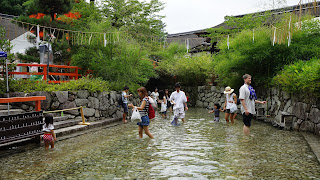Today I guided my guest to Nijo Castle and we
enjoyed the festival to commemorate the 150th anniversary of “Taisei Hokan”,
the return of the sovereignty to the Emperor by the Tokugawa Shogunate.
If you visit Nijo Castle, you would stroll inside the Ninomaru
Palace consists of 33 rooms. One of the biggest room is historical place where
the last Tokugawa Shogun announced the plan to give the power back to the
Emperor.

This historical picture depicts the moment when the Shougun announced the plan and his follower was listening the shocking announcement.
You can enjoy virtual walking tour in Nijo Castle from following link.
http://www2.city.kyoto.lg.jp/bunshi/nijojo/nijoujou0930amana-p/nijoujou0930amana-p/tour.html
Around that time of the end of Tokugawa shogunate, there were a lot of revolutionaries in Kyoto city to change the Samurai regime. To prevent their revolutionary plan, Tokugawa shogunate organized the special police force called "Shinsengumi". In the show we enjoyed today, Vice Commander of "Shinsengumi" defeated some outlaws.
The show was held in front of Ninomaru palace. Blue uniform wearing man is the role of Hijikata Toshizo, Vice Commander of "Shinsengumi".
They are actors from Toei Kyoto Studio Park. The Japanese swords they are using is well made imitation so even sightseeing people can manage it.
Nijo Castle was the symbolic building of Tokugawa Shogunate in Kyoto to show off his power. It had the castle tower but it was burned out because of lightning. You can browse the tower from the following link.
National treasure "The area in and around the Kyoto city (Funaki-version)"
You can enjoy virtual walking tour in Nijo Castle from following link.
http://www2.city.kyoto.lg.jp/bunshi/nijojo/nijoujou0930amana-p/nijoujou0930amana-p/tour.html
Around that time of the end of Tokugawa shogunate, there were a lot of revolutionaries in Kyoto city to change the Samurai regime. To prevent their revolutionary plan, Tokugawa shogunate organized the special police force called "Shinsengumi". In the show we enjoyed today, Vice Commander of "Shinsengumi" defeated some outlaws.
The show was held in front of Ninomaru palace. Blue uniform wearing man is the role of Hijikata Toshizo, Vice Commander of "Shinsengumi".
They are actors from Toei Kyoto Studio Park. The Japanese swords they are using is well made imitation so even sightseeing people can manage it.
Nijo Castle was the symbolic building of Tokugawa Shogunate in Kyoto to show off his power. It had the castle tower but it was burned out because of lightning. You can browse the tower from the following link.
National treasure "The area in and around the Kyoto city (Funaki-version)"
This folding screen was painted around 1615. It was the time of "Siege of Osaka", Tokugawa Shogunate attacked the castle of his rival Toyotomi. Following historical drama depicting the scene that Tokugawa Ieyasu taking the enemy's former vassal into his side.(Around 0:35)
"Historical Drama “Sanada Maru”"
Nijo Castle was used not only for military purpose but also for diplomatic purpose by showing off magnificent folding screen paintings.
Talking back to the folding screen that I showed with link address above,
it is called "rakuchū rakugai-zu" in Japanese and that means paintings of the area in and around Kyoto city. I really like it, actually my blog title is inspired by the name of the folding screen. And it is interesting to note that "Rakuchū ", inside the Kyoto city was surrounded by rampart wall.

GFDL, Link
After visiting Nijo Castle, I guided my guest to the oldest building inside the above former rampart wall. The main hall of Senbonshakado was built in 1227. It was almost 800 years ago and the main hall has survived war fire and fire incidents. It also holds interesting "Six Kanon statues" carved in that time and they are designated as National Treasure. I would write about them in other time.
On the way to back to the hotel, we talked about their next destination "Uji city" famous for green tea production. I told them a well known joke about tea is that "Green tea flows out instead of water when you turn on a faucet in school located in Uji city."
They also talked me a joke. They have watched a Japanese anthology horror film "Kwaidan " consists of four separate stories and one of them was "Hoichi the Earless". The thing was my name "Koichi" is similar to "Hoichi" and they were relief to know that I am not "Hoichi the Earless".
"Historical Drama “Sanada Maru”"
Nijo Castle was used not only for military purpose but also for diplomatic purpose by showing off magnificent folding screen paintings.
Talking back to the folding screen that I showed with link address above,
it is called "rakuchū rakugai-zu" in Japanese and that means paintings of the area in and around Kyoto city. I really like it, actually my blog title is inspired by the name of the folding screen. And it is interesting to note that "Rakuchū ", inside the Kyoto city was surrounded by rampart wall.

GFDL, Link
After visiting Nijo Castle, I guided my guest to the oldest building inside the above former rampart wall. The main hall of Senbonshakado was built in 1227. It was almost 800 years ago and the main hall has survived war fire and fire incidents. It also holds interesting "Six Kanon statues" carved in that time and they are designated as National Treasure. I would write about them in other time.
On the way to back to the hotel, we talked about their next destination "Uji city" famous for green tea production. I told them a well known joke about tea is that "Green tea flows out instead of water when you turn on a faucet in school located in Uji city."
They also talked me a joke. They have watched a Japanese anthology horror film "Kwaidan " consists of four separate stories and one of them was "Hoichi the Earless". The thing was my name "Koichi" is similar to "Hoichi" and they were relief to know that I am not "Hoichi the Earless".



















